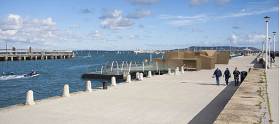Displaying items by tag: Badeschiff
The €2.75 million urban beach proposed for Dun Laoghaire Harbour is 'currently on hold' pending 'organisational restructure', according to a report in the Irish Times. A spokesman for the state company told the newspaper 'we hope to have it back next year in planning next year for opening in 2018'.
Dun Laoghaire Harbour company is one of the joint funders of the project.
As Afloat.ie previously reported, the Dun Laoghaire project, that is modelled on Berlin's Badeschiff, has an artificial beach at the East Pier and a floating barge that contains a swimming pool.
It was orginally envisaged to have the swimming pool operational inside Dun Laoghaire harbour in April 2014.
The Dun Laoghaire 'Heated' Baths went out to tender in December 2012. In October 2013 DLRCoCo Applied for a Foreshore Consent for the Baths Refurbishment on the back of the East Pier and at Newtownsmith.
In the Irish Times article, author Justin Comiskey points to the idea that baths projects act as engines of renewal or to give underused urban spaces an identity. Read more here.
#urbanbeach – Dún Laoghaire Harbour Company hopes to be in a position to open a floating swimming pool and urban beach at the historic East Pier of the Harbour for the 2016 summer season.
Permission was granted in late-2014 by Dún Laoghaire Rathdown County Council, but had been appealed as Afloat.ie reported at the weekend.
The project has been inspired by the popular Badeschiff facility in Berlin, a floating swimming pool on the River Spree. The plan for Dún Laoghaire Harbour includes a floating swimming pool containing heated and treated seawater, utilising a converted river barge which will be located within the Harbour. The facility will include an Urban Beach alongside the floating structure, on Berth 1 adjacent to the East Pier. Changing and toilet facilities, a café, an administration area, and security features are also planned.
The Harbour Company estimates that urban beach has the potential to attract 100,000 visitors per year and to generate over €1 million per annum for the local economy.
Dún Laoghaire Harbour Company hopes to be in a position to open the facility for the summer season in 2016.
According to Tim Ryan, Operation Manager, of DLHC: "Today's go-ahead by An Bord Pleanála is very welcome, and marks a vital step in realising the full potential of the Harbour as a marine, leisure and tourist destination of international calibre."
"The urban beach will be a hugely exciting project for Dun Laoghaire as a while. It is very much in keeping with the Government's National Ports Policy which designated Dún Laoghaire as a harbour focusing on marine leisure, marine tourism, and urban development. Today's decision allows us to follow through on our mandate.
Over the coming months, Dún Laoghaire Harbour Company Harbour is set to welcome a record 100,000 cruise passengers and crew. "Combined with the news of the urban beach, the future for Dun Laoghaire Harbour is really shaping up, as set out in the Company's Masterplan of 2011," added Tim.
Dun Laoghaire 'Urban Beach' Faces Fresh Planning Objection
#DunLaoghaire - Despite getting the green light from planners six weeks ago, Dun Laoghaire's 'urban beach' project faces an appeal made against it to An Bórd Pleanála.
According to The Irish Times, councillors in Dun Laoghaire-Rathdown have been told of an appeal lodged in late December against the €2.5 million scheme modelled on Berlin's famous Badeschiff.
It has not been made known who made the appeal, though the original planning application received 15 objections during the public consultation from local groups and individuals.
Many of these expressed concern at potential damage to the protected East Pier where the Badeschiff would be installed, and also argued for council funds to be instead directed towards restoration of the derelict Victorian Baths nearby.
The Irish Times has more on the story HERE.

























